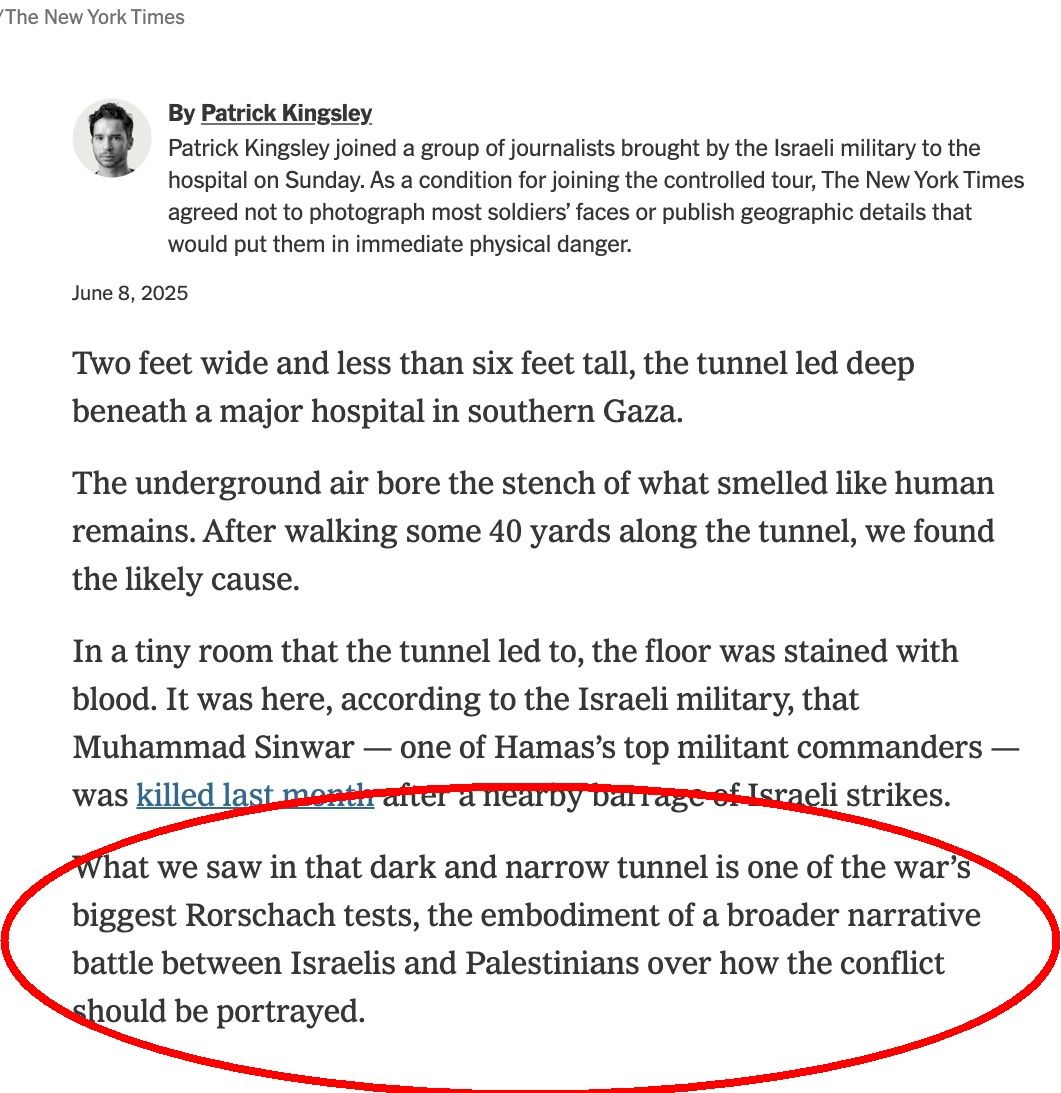The New York Times building in New York City. Photo: Wikimedia Commons
The child in Hans Christian Andersen’s folktale The Emperor’s New Clothes says the truth when he sees it — that the vain ruler being paraded through town in his “new clothes” is actually naked.
But when The New York Times’ Patrick Kingsley saw the naked truth as the Israeli army led him into a Hamas tunnel underneath a Gaza hospital, he went out of his way to twist the facts and avoid embarrassing the terror group.
Instead of questioning the legality of Hamas head Mohammed Sinwar hiding under the European Hospital in Gaza, Kingsley’s article includes biased premises and unprofessional use of quotes that delegitimize Israel’s targeting of the top terrorist.
And it’s all the more alarming because Kingsley is the Times’ Jerusalem bureau chief, responsible for leading the coverage of Israel, Gaza, and the West Bank for the once-respected newspaper.
Biased Premises
Kingsley’s bias is exposed in two main issues: one is obvious and the other covert.
The first one is displayed in the sub-header. It casts immediate doubt on the simple fact — which Kingsley saw with his own eyes — that Hamas violates international law by using Palestinians as human shields:
Unbelievable. A @nytimes journalist is taken into a tunnel underneath a hospital, and this is his morally subverted takeaway?
Instead of questioning the legality of Hamas head Sinwar hiding there, @PatrickKingsley goes out of his way to delegitimize Israel’s targeting of him. pic.twitter.com/1pYqgbFoXG
— HonestReporting (@HonestReporting) June 9, 2025
The bias is also on display in the fourth paragraph, which follows three opening paragraphs that accurately describe the facts. In it, Kingsley likens the terror tunnel he saw to a Rorschach test, a psychological assessment in which people give different interpretations to a series of inkblots:

What we saw in that dark and narrow tunnel is one of the war’s biggest Rorschach tests, the embodiment of a broader narrative battle between Israelis and Palestinians over how the conflict should be portrayed.
A journalist who thinks that a terror tunnel underneath a hospital has more than one interpretation is performing reality-denying mental gymnastics.
Kingsley, it seems, may have a severe case of anti-Israeli tunnel vision. Because instead of seeing the truth about Hamas, he looked at a Rorschach’s inkblot and saw Israel as the terrorists.
But his most damning bias is covert. Throughout the entire article, which seems to care about the loss of Palestinian lives, Kingsley doesn’t wonder even once why the tunnels aren’t used to shelter civilians. He takes for granted that only terrorists can use them.
This reveals that Kingsley does not expect Hamas to show any mercy for their own people, which is exactly what he demands from Israel.
Unprofessional Use of Quotes
What makes all of this possible is Kingsley’s unprofessional use of quotes.
In four instances, Kingsley uses the vague term “Palestinians” to cement his claim — or opinion — that to them, Israel’s actions show disregard for civilian life.
But only one Palestinian is quoted saying that, in paragraph 14 — Dr. Salah al-Hams, the official spokesman of the hospital under which Sinwar was hiding.
Any journalist worth his salt should know that spokespeople of official institutions in Gaza are most likely Hamas-approved, and anyway won’t say anything against the terror group because of fears of reprisal.
But this should come as no surprise; HonestReporting has already exposed how The New York Times relies on Gaza photojournalists who were awarded as “work partners” by Hamas.
Kingsley also quotes the chief Israeli military spokesman, Brigadier General Effie Defrin. But he twists his words like he twists the facts: Defrin is quoted as saying he could not provide a definitive answer as to Sinwar’s death, and speculates it may have been the result of suffocation or a shockwave unleashed by the explosions.
Despite Defrin’s complete denial, Kingsley takes this to mean that the top terrorist may have been “intentionally poisoned by gases released by such explosions.” He dedicates three paragraphs to this blood libel, which borders on comparison of Israel’s actions to those of the Nazis.
He does the same with the accusation, also denied by the IDF spokesperson, that the army has been using Palestinians as human shields.
Ironically, Kingsley did not ask Hamas for comment. He only pressed the IDF for answers, even though it’s Hamas that was exposed in its nakedness.
The reason for this ethical and journalistic failure is that, unlike the child in Andersen’s folktale, Kingsley and The New York Times are foolish or willfully blind.
Either way, they are morally and professionally bankrupt.
The author is a contributor to HonestReporting, a Jerusalem-based media watchdog with a focus on antisemitism and anti-Israel bias — where a version of this article first appeared.
The post The New York Times’ Anti-Israeli Tunnel Vision first appeared on Algemeiner.com.
Click this link for the original source of this article.
Author: Rinat Harash
This content is courtesy of, and owned and copyrighted by, https://www.algemeiner.com and its author. This content is made available by use of the public RSS feed offered by the host site and is used for educational purposes only. If you are the author or represent the host site and would like this content removed now and in the future, please contact USSANews.com using the email address in the Contact page found in the website menu.








